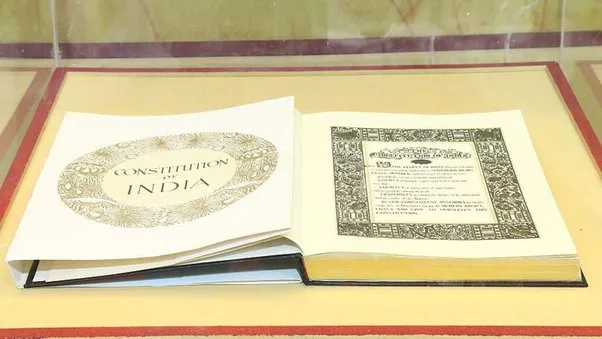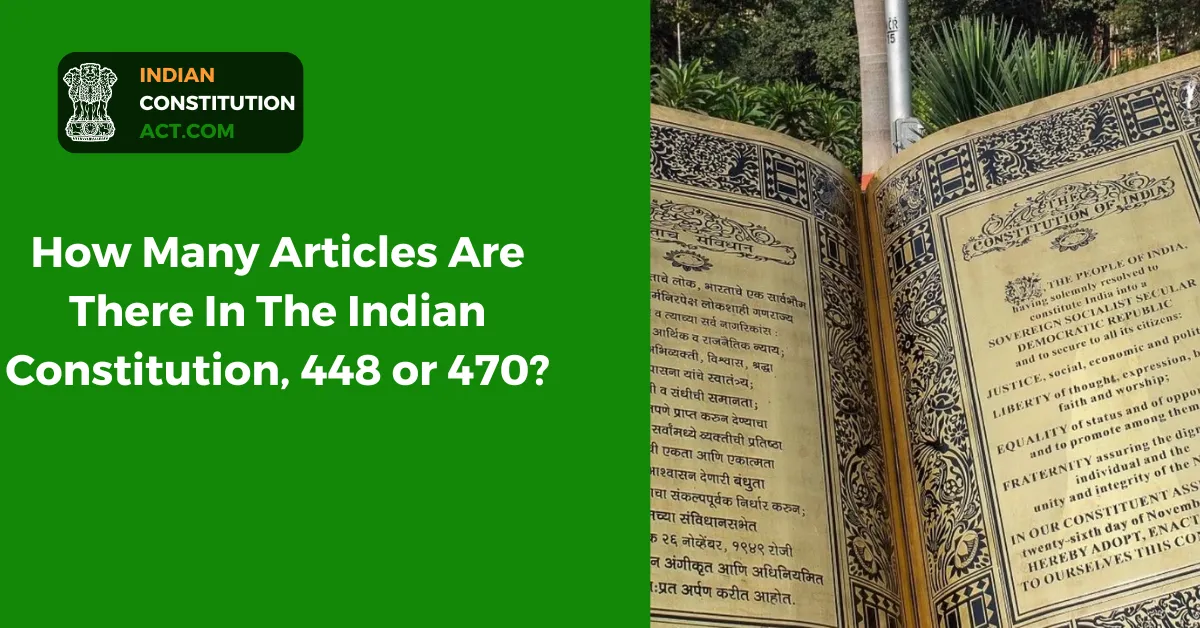In India, till now some people have been confused about our Indian Constitution. Still, some people are now aware of whether the Constitution of India has 448 articles 470. It is important to learn about the Constitution. The constitution was officially adopted on 26th January 1950. It is a comprehensive and detailed document that served as the supreme law of the country. To know everything, read out this entire blog.
What Is The Indian Constitution?

The Indian Constitution was adopted on 26th January 1950. It is a comprehensive and detailed document that served as the supreme law of the country. It aims to lay down the framework for the governance of India, its responsibilities, ensuring the rights, and also the principles that guide the functioning of the nation. A committee was first officially formed on 9th December 1946 to draft the Constitution of India.
Also read: Are there 470 Articles In The Indian Constitution?
How Many Articles Are There In Indian Constituion: 448 or 470?
There is a total of 448 articles in the Indian Constitution. Those 448 articles are in 25 parts and 12 schedules and has made 105 amendments to add all these. Initially, when the Constitution was drafted there were a total of 395 articles in 22 parts and 8 schedules.
Part 1: Article 1 to Article 4
Article 1: Name and territory of the union.
Article 2: Admission and establishment of the new state.
Article 3: Formation of new states and alteration of areas, boundaries, and name of existing states.
Article 4: Laws made under articles 2 and 3 to provide for the amendment of the first and fourth schedules and supplemental, incidental and consequences matters.
Part 2: Article 5 to Article 11
Article 5: Citizenship at the commencement of the constitution.
Article 6: Rights of citizenship of a certain person who has migrated to India from Pakistan.
Article 10: Continuance of rights of citizenship.
Article 11: Parliament to regulate the right of citizenship by law.
Part 3: Article 12 to Article 35
Article 12: Definition of the state.
Article 13: Laws inconsistent with or in derogation of the fundamental rights.
Right to Equality: Article 14 to Article 18
Article 14: Equality before the law.
Article 15: Prohibition of discrimination on the grounds of religion, race, caste, sex, or place of birth.
Article 16: Equality of opportunity in matters of public employment.Article 17: Abolition of the untouchability.
Article 18: Abolition of titles.
Right to Freedom: Article 19 to Article 22
Article 19: Guarantees to all the citizens the six rights and they are:
a) Freedom of speech and expression.
b) Freedom to assemble peaceably and without arms.
c) Freedom to form associations or unions.
d) Freedom to move freely throughout the territory of India.
e) Freedom to reside and settle in any part of the territory of India.
f) Omitted
g ) Freedom to practice any profession, or to carry on any occupation, trade, or business.
Article 20: Protection in respect of conviction for offenses.
Article 21: Protection of life and personal liberty.
Article 22: Protection against arrest and detention in certain cases.
Right Against Exploitation: Article 23 to Article 24
Article 23: Prohibition of traffic in human beings and forced labor.
Article 24: Prohibition of employment of children (Under the age of 14) in factories and mines.
Right to Freedom of Religion: Article 25 to Article 28
Article 25: Freedom of conscience and free profession, practice, and propagation of religion.
Article 26: Freedom to manage religious affairs.
Article 27: Freedom to pay taxes for the promotion of any particular religion.
Article 28: Freedom from attending religious instruction.
Cultural and Educational Rights: Article 29 to Article 30
Article 29: Protection of interest of minorities.
Article 30: Right of minorities to establish and administer educational institutions.
Right to Constitutional Remedies: Article 32
Article 32: Remedies for enforcement of Fundamental Rights.
Part 4: Directive Principal of States Policy: Article 36 to Article 51
Article 36: Definition
Article 37: Application of DPSP
Article 39A: Equal justice and free legal aid
Article 40: Organization of a Village Panchayat
Article 41: Right to work, education, and public assistance in certain cases
Article 43: Living Wages, etc. for workers.
Article 43A: Participation of workers in the management of industries.
Article 44: Uniform civil code.
Article 45: Provision for free and compulsory education for children.
Article 46: Promotion of educational and economic interest of scheduled castes (SC), scheduled tribes (ST), and OBC.
Article 47: Duty of the state to raise the level of nutrition and the standard of living and to improve public health.
Article 48: Organization of agriculture and animal husbandry.
Article 49: Protection of monuments and places and objects of natural importance.
Article 50: Separation of judiciary from the executive.
Article 51: Promotion of international peace and security.
Part 4A: Fundamental Duties
Article 51A: There are a total of 11 fundamental duties. The 42nd Amendment Act 1976 added 10 fundamental duties, 86th Amendment Act 2002 added one more to the list.
Part 5: Union
Article 52: The President of India
Article 53: Executive Power of the Union
Article 54: Election of President
Article 61: Procedure for Impeachment of the President
Article 63: The Vice–president of India
Article 64: The Vice–President to be ex-official chairman of the Council of States
Article 66: Election of Vice–president
Article 72: Pardoning powers of President
Article 74: Council of ministers to aid and advise President
Article 76: Attorney–General for India
Article 79: Constitution of Parliament
Article 80: Composition of Rajya Sabha
Article 81: Composition of Lok Sabha
Article 83: Duration of Houses of Parliament
Article 93: The speakers and Deputy speakers of the House of the People
Article 105: Powers, Privileges, etc. of the House of Parliament
Article 109: Special procedure concerning money bills
Article 110: Definition of “Money Bills”
Article 112: Annual Financial Budget
Article 114: Appropriation Bills
Article 123: Powers of the President to promulgate Ordinances during recess of parliament
Article 124: Establishment of Supreme Court
Article 125: Salaries of Judges
Article 126: Appointment of acting Chief Justice
Article 127: Appointment of ad–hoc judges
Article 128: Attendance of retired judge at sitting of the Supreme Court
Article 129: Supreme Court to be a Court of Record
Article 130: Seat of the Supreme Court
Article 136: Special leaves for an appeal to the Supreme Court
Article 137: Review of judgment or orders by the Supreme Court
Article 141: Decision of the Supreme Court of India binding on all the courts
Article 148: Comptroller and Auditor–General of India article
Article 149: Duties and Powers of CAG
Part 6: States
Article 153: Governors of StateArticle
Article 154: Executive Powers of Governor
Article 161: Pardoning powers of the Governor
Article 165: Advocate–General of the State
Article 213: Power of Governor to promulgate ordinances
Article 214: High Courts for states
Article 215: High Courts to be a court of record
Article 226: Power of High Courts to issue certain writs
Article 233: Appointment of District judges
Article 235: Control over Subordinate Courts
Part 7: Repealed
Article 238
Part 8: Union Territories
Article 239
Article 240
Article 241
Article 242
Part 9: Panchayats
Article 243A: Gram Sabha
Article 243B: Constitution of Panchayats
Part 9A: Municipalities
Article 243 P to Article 243 ZG
Part 10: Scheduled and Tribal Areas
Article 244
Part 11: Center-state Relations
Articles 245 to 263
Part 12: Finance, Properties, Contracts, and Suits
Article 266: Consolidated Fund and Public Accounts Fund
Article 267: Contingency Fund of India
Article 280: Finance Commission
Article 300A: Right to property
Part 13: Trade, Commerce, and Intercourse with Territories of India
Article 301: Freedom to trade, commerce, and intercourse
Article 302: Power of Parliament to impose restrictions on trade, commerce, and intercourse.
Part 14: Services Under Centre and State
Article 312: All– India–Service
Article 315: Public service commissions for the union and the states
Article 320: Functions of Public Service Commission
Part 14A: Tribunals
Article 323A: Administrative Tribunals
Part 15: Elections
Article 324: Superintendence, direction, and control of Elections to be vested in an Election Commission
Article 325: No person to be ineligible for inclusion in or to claim to be included in a special, electoral roll on grounds of religion, race, caste, or sex
Article 326: Elections to the House of the People and to the legislative assemblies of states to be based on adult suffrage
Part 16: Special Provisions to SC, ST, OBC, Minorities, etc
Article 338: National Commission for the SC & ST
Article 340: Appointment of a commission to investigate the conditions of backward classes
Part 17: Offical Language
Article 343: Official Languages of the Union
Article 345: Official languages or languages of a state
Article 348: Languages to be used in the Supreme Court and the High Courts
Article 351: Directive for development of the Hindi languages
Part 18: Emergency
Article 352: Proclamation of Emergency
Article 356: State Emergency
Article 360: Financial Emergency
Part 19: Miscellaneous
Article 361: Protection of President and Governors
Article 361A: Protection of publication of proceedings of Parliament and State Legislatures.
Article 361B: Disqualification for appointment on a remunerative political post.
Article 362: [Repealed]
Article 363: Bar to interference by courts in disputes arising out of certain treaties, agreements, etc.
Article 363A: Recognition granted to Rulers of Indian States to cease and privy purses to be abolished.
Article 364: Special provisions as to major ports and aerodromes.
Article 365: Effect of failure to comply with, or to give effect to, directions given by the Union.
Article 366: Definitions
Article 367: Interpretation
Part 20: Amendment of Constitution
Article 368: Powers of Parliaments to amend the constitution
Part 21: Special, Transitional, and Temporary Provisions
Article 370: Temporary Provision for the erstwhile State of J&K (diluted on August 5 & 6, 2019).
Article 371: Special provision concerning the States of Maharashtra and Gujarat.
Article 371A: Special provision concerning the State of Nagaland.
Article 371B: Special provision concerning the State of Assam.
Article 371C: Special provision concerning the State of Manipur.
Article 371D: Special provisions concerning the State of Andhra Pradesh.
Article 371E: Establishment of Central University in Andhra Pradesh.
Article 371F: Special provisions concerning the State of Sikkim.
Article 371G: Special provision concerning the State of Mizoram.
Article 371H: Special provision concerning the State of Arunachal Pradesh.
Article 371-I: Special provision concerning the State of Goa.
Article 371J: Special provision concerning the State of Karnataka.
Article 372: Continuance in force of existing laws and their adaptation.
Article 372A: Power of the President to adapt laws.
Article 373: Power of the President to make orders in respect of persons under preventive detention in certain cases.
Article 374: Provisions as to Judges of the Federal Court and proceedings pending in the Federal Court or before His Majesty in Council.
Article 375: Courts, authorities, and officers to continue to function subject to the provisions of the Constitution.
Article 376: Provisions as to Judges of High Courts.
Article 377: Provisions as to Comptroller and Auditor-General of India.
Article 378: Provisions as to Public Service Commissions.
Article 378A: Special provision as to the duration of Andhra Pradesh Legislative Assembly.
Article 379-391: [Repealed.]
Article 392: Power of the President to remove difficulties.
Part 22: Short Test, Commencement, Authoritative Text in Hindi, and Repeals
Article 393: Short title – This Constitution may be called the Constitution of India.
Article 394: Commencement.
Article 394A: Authoritative text in the Hindi language.
Article 395: Repeals.
